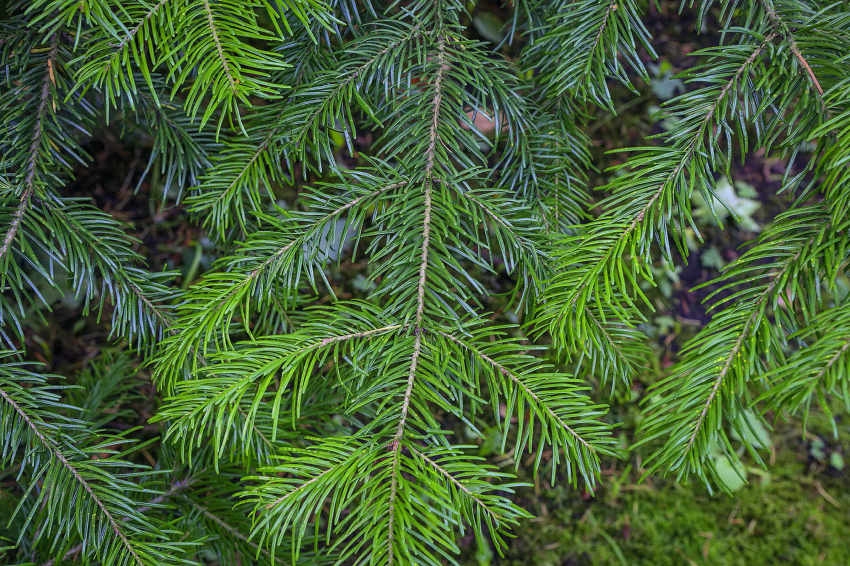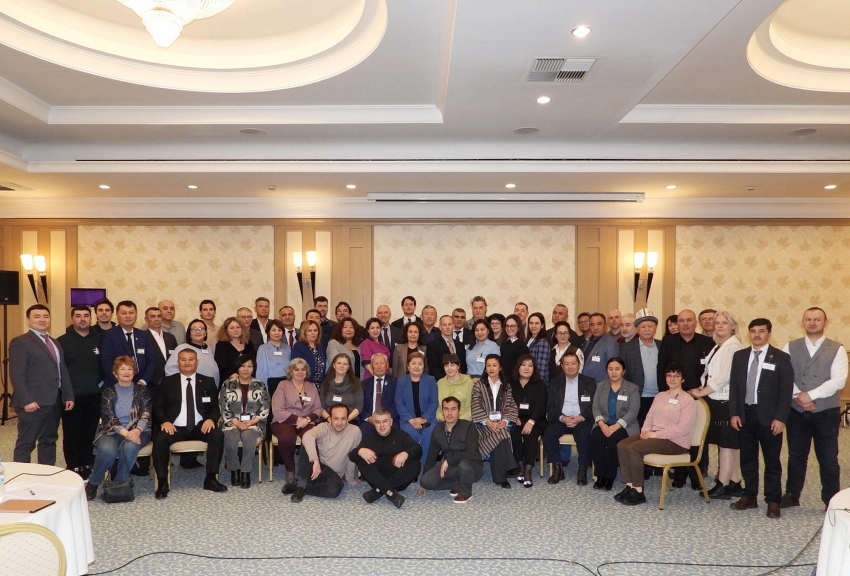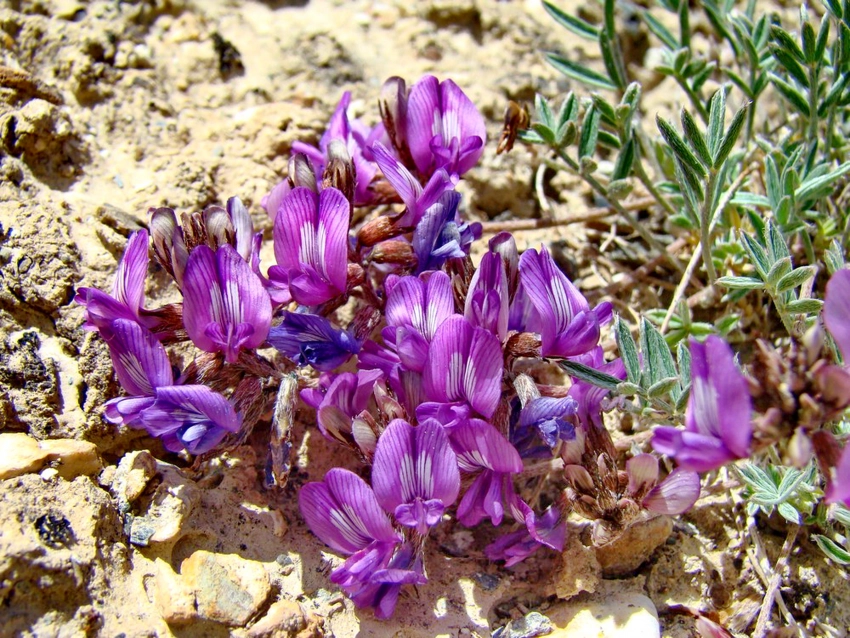RED BOOK: KGZ10 Key Biodiversity Area Chychkan
Species that initiated the allocation of KBA [and other globally threatened species that are present in the КBA but have not been confirmed to meet the global criteria for КBA]: Plants: Semenov fir (Abies semenovii), Chichkansky onion (Allium chychkanense), Tsinovskis cotoneaster (Cotoneaster cinovskisii), Knorring hawthorn (Crataegus knorringiana), Draba sarycheleki (Draba sarycheleki), Juno Zinaida (Juno zenaida), Leibnitzia Knorring (Leibnitzia knorringiana), Sage Vvedensky (Salvia vvedenskyi), Korzhinsky's Gill (Seseli korshinskyi), Suusamyr Smolevka (Silene sussamyrica)
Leibnizia Knorring (Leibnitzia knorringiana)
Leibnitsia (lat. Leibnitzia) is a genus of perennial flowering plants included in the tribe Mutisieae of the Asteraceae family. Includes about 8 species.
Botanical description of the genus:
Representatives of the genus are perennial herbaceous plants. The leaves are collected in a basal rosette, simple or pinnately dissected. Spring inflorescences-baskets with reed and median flowers. Reed flowers are pistillate, median flowers are bisexual, with short pistils, with lips approximately equal in length. Autumn baskets without reed flowers, middle flowers are small, two-lipped. The upper lip is dissected into narrow lobes, the lower lip with three inconspicuous teeth.
Fruits are spindle-shaped, flattened, pubescent, with a noticeable, not disappearing tuft.
On the territory of Eurasia, two species are known - stamenless Leibnizia and Knorring Leibnizia.
Interesting facts: The genus Leibnitz was named by Alexander Cassini in honor of the German philosopher and scientist Gottfried Wilhelm Leibniz (1646-1716), the creator of mathematical logic and combinatorics. Leibnizia astamenia is endowed with very valuable healing properties. An infusion prepared on the basis of its herb is recommended to be used as an emollient for various respiratory diseases, and is also used as bitterness.
Photo source:
Semenov fir (Abies semenovii)
Status: VU. Relic endemic of the Western Tien Shan. Decorative.
Description. Evergreen tree of the first magnitude: up to 30 m in height and up to 1 m in diameter at chest height, life expectancy up to 300-350 years. The crown is narrow-pyramidal, columnar, swept or umbrella-shaped. The needles up to 4 cm long are single, flat, linear, slightly two-topped, the bases are slightly twisted, dark green above, below with two wide light blue stomatal stripes, on vegetative branches straight or slightly curved, on generative branches - curved, wider and hard, needles live up to 15 years. Cones are oval-cylindrical, 8-10 cm long and 3-4 cm wide. The scales are more or less broadly wedge-shaped with a gently curved upper margin. Seeds with a short wing not exceeding them by 1.5 times.
Features of biology. Mesophyte, shade-tolerant. Propagation by seeds and cuttings. Seed renewal in plantations mixed with spruce is satisfactory, in walnut-dark coniferous plantations it is weak. In pure fir forests, renewal is extremely rare. In the first years it grows slowly, begins to bear fruit in 50 - 60 years.
The distribution is general and in the country. Western Tien Shan, slopes of At-Oinok, Uzun-Akmat and Chatkal ridges, as well as in a small area in Talas (gorge of the Besh-Tash river) and Suusamyr Ala-Too, the easternmost gorges of Kyzyl-Kol, Chichkan.
Places of growth. The belt of dark coniferous forests at an altitude of 1300-2800 m above sea level. m; predominantly on the slopes of northern and northeastern exposure, together with Schrenk spruce. On the lower border of distribution in walnut-dark coniferous forests, also along mountain river valleys, in combination with a number of trees and shrubs. The area of optimal development of fir forests, middle mountains, within the absolute heights of 2000-2500 m.
Number. In the Kyrgyz Republic, fir forests have been preserved on an area of 3.7 thousand hectares, over the past 10 years the area of plantations has increased by 0.5 thousand hectares, but its pure plantations are extremely rare.
Limiting factors. Unsystematic felling in the past. Forest fires, overgrazing. mycotic disease - cenangial cancer.
Cultivation. Cultivated in many botanical gardens.
Security measures are in place. It has been protected on the territory of the republic since 1975 in accordance with the decree of the Council of Ministers of the Kyrgyz SSR. Listed in the Red Book of the USSR (1984), the Red Book of the Kirghiz SSR (1985). The species is protected in the Sary-Chelek Biosphere Reserve.
Protective measures are recommended. Organize botanical reserves in places of the highest concentration of the species.
Interesting facts: Semenov fir can be seen only in Kyrgyzstan, it does not grow in any other place on the globe. This tree is amazingly beautiful, has dense lush evergreen needles and can grow up to a height of 30 m.
Fir is located mainly on shady slopes with a steepness of over 30 degrees, can grow on stony soils, but requires good moisture. In the south of Kyrgyzstan, in the Chatkal Range, entire forests of Semyonov's fir have been preserved. Usually it grows together with spruce. Fir wood is highly valued, significantly superior in quality to spruce. It is light, soft, but very durable. In addition, a balm is made from fir resin that heals wounds, and an essential oil is made from needles, which is used in the perfumery and pharmaceutical industries.
Source: Red Book of the Kyrgyz Republic. 2nd edition - Bishkek, 2007.
Source:
Chychkan onion (Allium chychkanense) Chychkan piyazy.
Place of growth: piedmont-mid-mountain zone (800-2500 m). Areas within two floristic regions of the Mountain Central Asian province - Chatkal and East Fergana.
Biological description: Perennial 40-70 cm tall. Inflorescence spherical, loose. The flowers are light lilac. Stamens straight, white, protruding from the corolla. Anthers are dark.
Filaments of stamens equal to or slightly longer than tepals, fused at base with perianth and higher, inner stamens almost 2-2.5 times wider than outer ones, higher subulate, inner stamens with shapeless teeth at base; tepals 6-8 mm in height, from lanceolate to triangular, elongated, brilliant pink, soon turned back, but tips slightly curved inwards, with a slightly prominent middle green vein, visible only on the outer side at the tip of the leaves; pedicels equal, 2.5-3 times longer than tepals.
Interesting facts: Long-term observations show that under cultural conditions, when created close to their natural conditions, bows are unpretentious, feel good and reproduce. It may well be material for further reintroduction.
Limiting factors. Human economic activity: spring grazing, picking flowers, digging bulbs.
Recommended protective measures. Organization of botanical reserves in places of the highest concentration of the species, monitoring of the state of populations. Prohibit digging bulbs, grazing.
Photo source:
Cinovskis’ cotoneaster (Cotoneaster cinovskisii)
Distribution: The range of this species is Central Asia (Kyrgyzstan, Kazakhstan). Grows mostly in temperate biome.
Botanical description of the genus:
Cotoneaster (Cotoneaster) is a genus of non-thorny shrubs, less often small trees of the Rosaceae family. The Latin name of the genus comes from the Greek "cotonea" - quince, "aster" - having the appearance, by the similarity of quince leaves and one of the cotoneaster species.
Cotoneasters are deciduous or evergreen slow-growing shrubs, less often small trees or, on the contrary, shrubs with simple alternate buds and leaves.
The leaves are medium-sized, simple, alternate, entire, ovate, dark green in summer, turning red in autumn (most often shiny).
The flowers are white or pink, small, in corymbs, racemes or solitary. Hypanthium with 5 sepals, 5 petals and 20 stamens. The lower ovary is formed by 2-4, rarely 5 carpels fused with the hypanthium.
Cotoneaster fruits are small, red or black apples with 2-5 pits, immersed in mealy inedible pulp and sepals remaining at the top. The fruits of some species are edible.
Cotoneaster is propagated by seeds and vegetatively. Green cuttings root faster at high humidity, that is, under the film. The best time for cuttings is the second half of July. The substrate consists of a mixture of peat and sand, taken in equal quantities.
Interesting facts: Many types of cotoneasters are decorative, some are used to fix sandy slopes, as well as hedges. Cotoneaster has been known in the collections of botanical gardens since 1864. Currently, about 80 species, varieties and garden forms of cotoneaster are used as material for landscape design. Undemanding to soils and humidity, mostly frost-resistant and gas-resistant. Good for molding. Old bushes are easily rejuvenated by radical pruning. Deciduous species are pruned in February, evergreen - in April.
Source:
Photo source:
Hawthorn Knorringa (Crataegus knorringiana)
Status: VU. Narrow endemic species.
Description. Tree up to 5 - 6 m in height. Leaves narrowly elliptic or ovate, slightly lobed. The fruits are yellow, small, with five strongly pitted stones. The plant contains triterpenes.
Features of biology. Blossoms at the end of IV-beginning of V. The fruits ripen in IX. Vegetation ends in X. Seed propagation.
The distribution is general and in the country. Kyrgyzstan: river valley Chichkan, Chatkal, Fergana, Alai ranges.
Places of growth. Among trees and shrubs in river valleys, on rocky and fine earth slopes in the lower and middle mountain belts.
Number. Insignificant. Grows in single specimens.
Limiting factors. Economic development of the growing area. Used by the population for fuel. Very weak recovery.
Cultivation. No information
Security measures are in place. Included in the Red Book of the Kirghiz SSR (1985).
Protective measures are recommended. In Toskoul-Ata and Kara-Alma forestries, all remaining plants should be protected from felling and loss of young plants by livestock.
Photo source:
Source: Red Book of the Kyrgyz Republic. 2nd edition - Bishkek, 2007
Draba Sarychelek (Draba sarycheleki)
Genus krupka (draba) – Draba L.
Botanical description of the genus: Perennial, rarely biennial or annual herbaceous, usually undersized herbaceous plants, forming dense bushes or forming cushion-like tufts or carpet thickets. Stems often with a woody base, vegetative and flower-bearing. Flowering stems rising above the vegetative stems, usually leafless or with a few reduced leaves, occasionally leafy. The leaves are mostly collected in rosettes at the base of the stems and their branches, simple, small, more or less hairy, on petioles. Stem leaves, if present, sessile. Brushes apical, simple or branched, sometimes corymbose, closed, dense. The flowers are small, rarely medium in size, but always numerous, usually yellow or white, rarely lemon, purple, purple, orange and reddish. Sepals and petals including 4 pieces. Stamens including 6 pieces. The fruit is usually short, ovoid or lanceolate, sometimes oblong or linear; cracking, many-seeded pod. The valves of the pods are flat or slightly swollen, with a slightly visible reticulate venation.
Phenology. It blooms in April-May or more often in June for 30-40 days extremely abundantly, forming a continuous flower carpet.
Interesting facts: In culture since the beginning of the 18th century. In decorative gardening, 54 species are used. Quite famous in rock garden culture. It is known that some types of grains (grains of oak tree) are used in folk medicine. It was called children's celandine (Perm province), chistets (Ukraine) and was used as a hemostatic, diuretic and blood-purifying agent, which helped with children's skin diseases.
Herbarium photo source:
Juno Zinaida (Juno zenaida)
Short description. Roots are fusiform. Bulb 1.5–1.8 cm in diameter, ovoid, covered with leathery, continuous dark brown shells. The leaves are slightly curved, lower 0.6–0.8 cm wide. Flowers in number 1–2; 4–5 cm in diameter. Perianth tube 3.5–4.0 cm long. The outer tepals are pale violet-gray or pale violet-yellowish, with a dark purple spot (in yellowish forms - brownish) at the tip of the plate of the outer petals and a yellow spot closer to the center of the flower; crest 0.9–1.1 cm long, yellow, slightly serrated. Inner tepals recurved downward, 1.0–2.0 cm long, lanceolate, with an elongated tip or 3-toothed.
Phenology. Blossoms in late March-April, bears fruit in June.
Ecology. Grows in groups of xerophilous shrubs (shibliaka), at altitudes of 800-1300 m above sea level. y. m.
Distribution in Kyrgyzstan. Chatkal and Fergana ranges. General distribution. Uzbekistan.
Cultivation. Cultivated in some private nurseries. Meaning. Rare decorative plant.
Security in Kyrgyzstan. No security measures were taken. Information sources. Lazkov, Naumenko (2014).
Source photo:
Source: Lazkov G.A., Umralina A.R. Endemics and rare plant species of Kyrgyzstan (Atlas) - FAO. Ankara, 2015.
Vvedensky’s Sage (Salvia vvedenskyi)
Status: VU. Very rare narrow endemic species. Decorative plant.
Description. Perennial. Stem is 40-60 cm tall, simple or branched in inflorescence, pale along the ribs, green along the edges, densely pubescent. The leaves are basal, long-petiolate, large, up to 8 cm long and 4 cm wide, pinnatipartite, with a green border along the stem, the lobes, in turn, are pinnately dissected or pinnately lobed. Stem leaves 3 per whorl, similar to basal, but smaller, short-petiolate, almost sessile, Flowers 2(3) per whorl, 5-7 of them on one branch of the inflorescence. Calyx campanulate, up to 13 mm long, enlarged in fruits, glandular-hairy. Corolla pinkish, up to 35 mm long, upper lip almost straight, bilobed, middle lobe of lower lip obovate cordate, wider than lateral ones. Nut fruit.
Features of biology. Blooms. U1-UP; bears fruit UP-USH. Seed reproduction.
The distribution is general and in the country. Endemic of Kyrgyzstan; Suusamyr ridge, Ketmen-Tube basin between the rivers Terek and Sogot-Suu, left bank of the Chichkan river.
Places of growth. On rocky and fine earth slopes in the middle belt of mountains.
Number. Very limited.
Limiting factors. Economic development of the territory.
Cultivation. There is no information.
Security measures are in place. Included in the Red Book of the Kirghiz SSR (1985).
Protective measures are recommended. To study the area and the state of the population. Organize a botanical reserve in the Ketmen-Tebe valley along the left bank of the river. Chichkan.
Photo source:
Source: Red Book of the Kyrgyz Republic. 2nd edition - Bishkek, 2007.
Gill Korzhinsky (Seseli korshinskyi)
Status: EN. A rare endemic species found in small numbers and in a limited area. The species is of great scientific importance.
Description. Perennial, polycarpic, dark green plant 30-70 cm tall, with taproot. Caudex woody, densely covered with remnants of leaf petioles. Stems are rounded, branched from the base or middle. Basal leaves in a rosette, on petioles 3-10 cm long. Leaf blade up to 12 cm long, lanceolate in outline, pinnately dissected; segments 7-15 mm long, ovate or rhombic, on short petioles, shallowly lobed, unequally toothed, pubescent below, glabrous above. Stem leaves are reduced, the uppermost ones are reduced to sheaths. Umbrellas 4-6 cm in diameter, with 4-15 unequal, with fruits spaced, pubescent rays from the inside. Involucral leaflets 4-5 in number, linear-subulate, pubescent. Umbrellas 15-20-flowered, with unequal pedicels spaced at fruits. Involucral leaflets, 8-9 in number, similar to involucral leaflets. Petals are white, slightly notched, pubescent on the outside. Fruits up to 3.5 mm long, laterally compressed, short densely pubescent.
Features of biology. Blossoms in VII-VIII, bears fruit in VIII-IX.
The distribution is general and in the country. Mountains surrounding the Ketmen-Tube basin.
Places of growth. Stony-gravelly slopes, screes, limestones.
Number. Not installed. In habitats found in single specimens. limiting factors. Not known.
Cultivation. Not carried out.
Security measures are in place. Not guarded.
Protective measures are recommended. Create a botanical reserve in places with the highest concentration of plants.
Photo source:
Source: Red Book of the Kyrgyz Republic. 2nd edition - Bishkek, 2007.
Smolevka Suusamyrskaya (Silene sussamyrica)
Short description. Perennial plant with thick roots. The caudex is multi-headed, covered with remnants of leaf petioles, forming a dense turf or cushion. Stems 25-80 cm tall, simple, erect, glabrous, sticky at the top. Leaves 3-12 cm long., 2-6 mm wide., linear or linear-lanceolate, pointed at the apex, glabrous, with shortened shoots in the axils of stem leaves. Inflorescence racemose or racemose-visible-paniculate. Bracts 3-5 mm long, lanceolate, herbaceous. Pedicels 0.5-2.0 cm long, drooping during flowering, upright at fruits. Calyx (9) 10-12 mm long, tubular, purple or greenish along the veins. Calyx teeth 1.5-2.0 mm long, triangular, obtuse. Petals 12-14 mm long, yellowish green. The limb of the petal is 6-8 mm long, divided into linear lobes to the base, without a rim. Nail 8-10 mm long, oblong, glabrous. Filaments of stamens are bare. Capsule 10-12 mm long, 5-6 mm wide, ovoid. Carpophore (2) 3-4 mm long, pubescent.
Phenology. Flowering in July, fruiting in August.
Ecology. It grows on rocks, at altitudes of 1200-2200 m above sea level. y. m. Distribution in Kyrgyzstan. Ridges Akshiyrak, Moldo-Too, Susamyr, Uzun-Akhmat, Chaartash.
General distribution. Endemic.
Cultivation. No information available.
Meaning. Rare species.
Security in Kyrgyzstan. Included in the Red Book (2007).
Information sources. Lazkov (1991). Lazkov (2006-2012), expedition data.
Source photo:
Source: Lazkov G.A., Umralina A.R. Endemics and rare plant species of Kyrgyzstan (Atlas) - FAO. Ankara, 2015



















